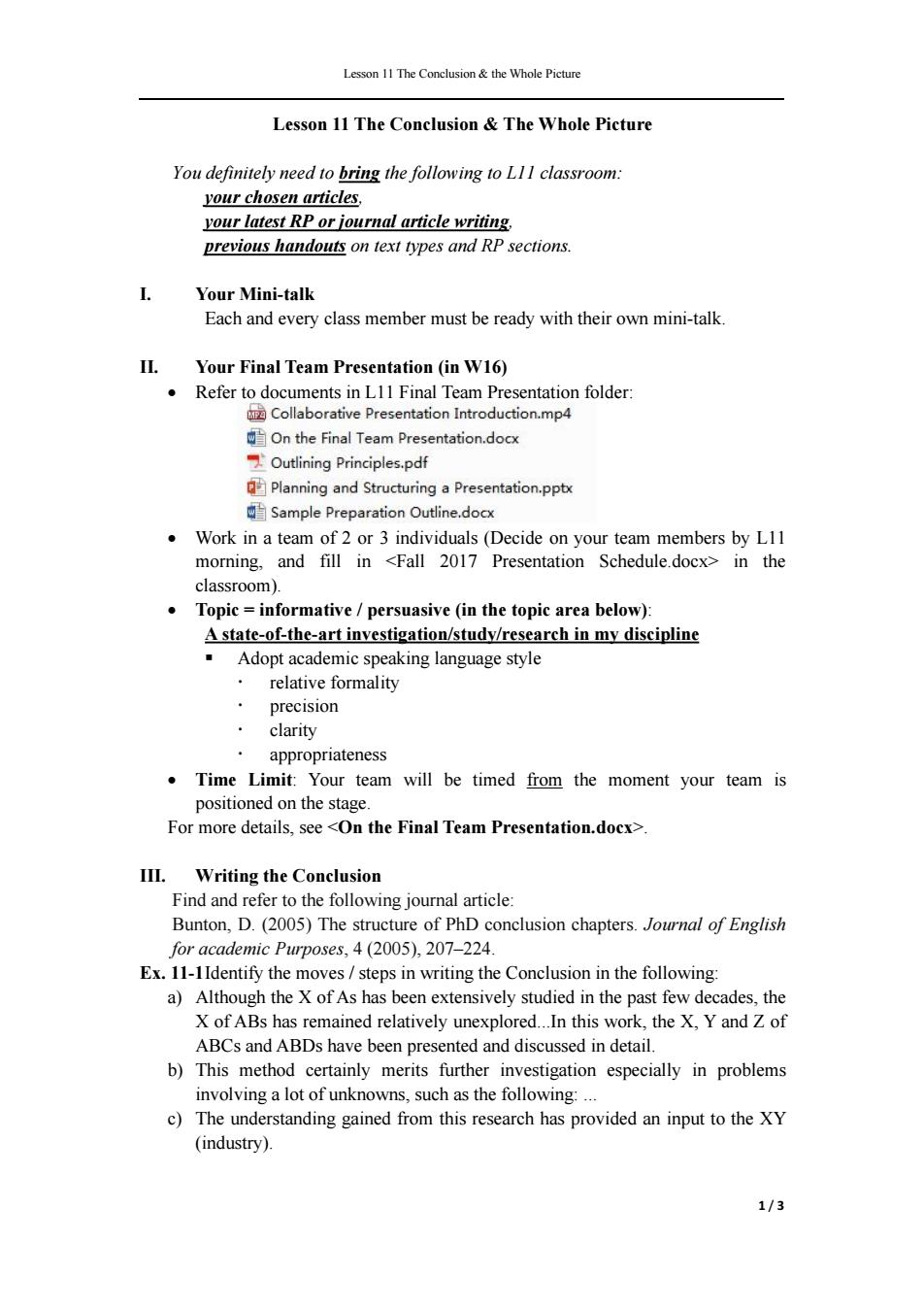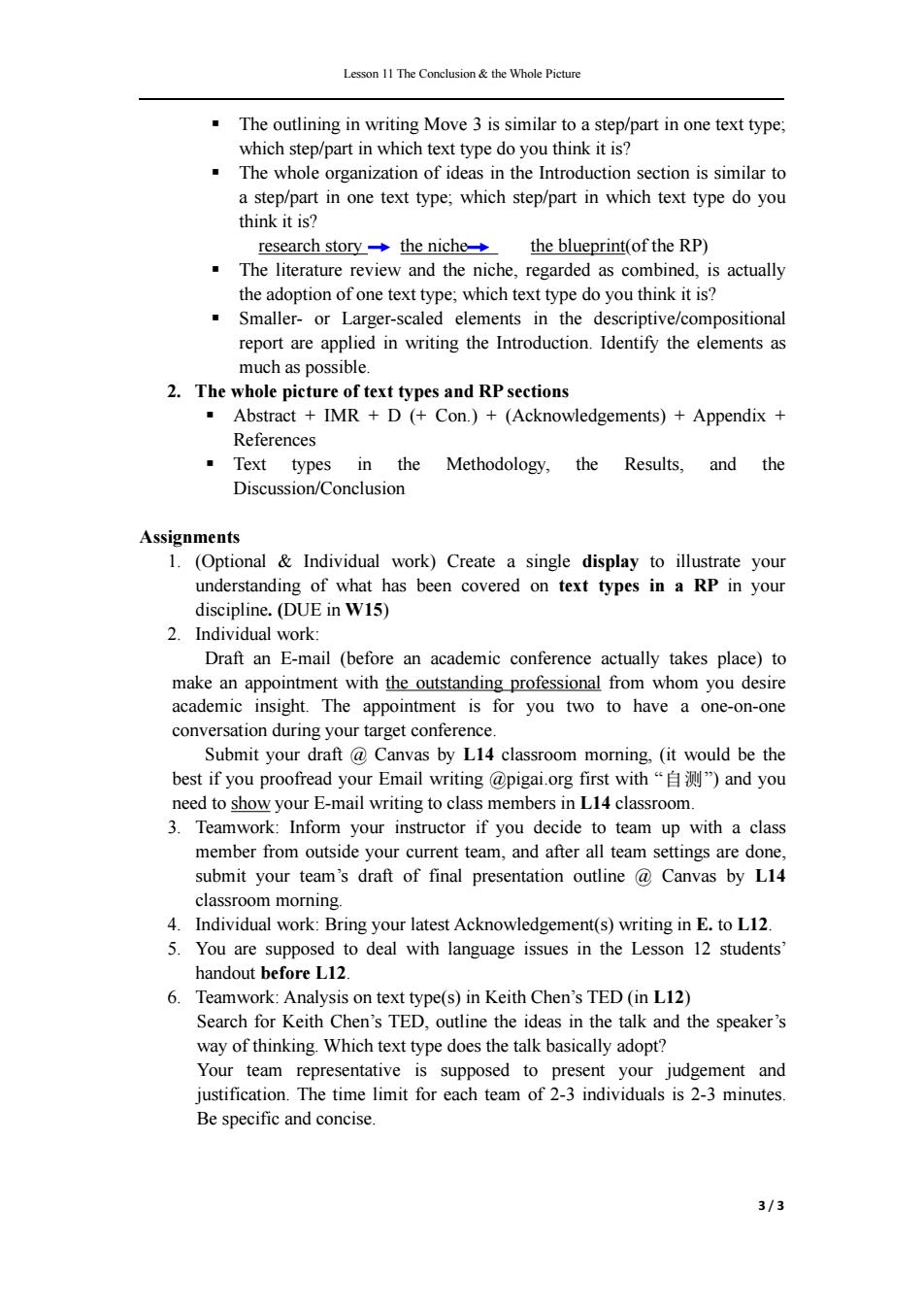
Lesson 11 The Conclusion the Whole Picture Lesson 11 The Conclusion The Whole Picture You definitely need to bring the following to L1I classroom: your chosen articles, your latest RP or journal article writing, previous handouts on text types and RP sections. Your Mini-talk Each and every class member must be ready with their own mini-talk. II.Your Final Team Presentation (in W16) .Refer to documents in L11 Final Team Presentation folder: Collaborative Presentation Introduction.mp4 On the Final Team Presentation.docx Outlining Principles.pdf Planning and Structuring a Presentation.pptx Sample Preparation Outline.docx Work in a team of 2 or 3 individuals(Decide on your team members by L11 morning,and fill in in the classroom). ● Topic informative persuasive(in the topic area below): A state-of-the-art investigation/study/research in my discipline Adopt academic speaking language style ·relative formality precision ·clarity appropriateness Time Limit:Your team will be timed from the moment your team is positioned on the stage. For more details,see . III.Writing the Conclusion Find and refer to the following journal article: Bunton,D.(2005)The structure of PhD conclusion chapters.Journal of English for academic Purposes,4(2005),207-224. Ex.11-1Identify the moves/steps in writing the Conclusion in the following: a)Although the X of As has been extensively studied in the past few decades,the X of ABs has remained relatively unexplored...In this work,the X,Y and Z of ABCs and ABDs have been presented and discussed in detail. b)This method certainly merits further investigation especially in problems involving a lot of unknowns,such as the following:... c)The understanding gained from this research has provided an input to the XY (industry) 1/3
Lesson 11 The Conclusion & the Whole Picture 1 / 3 Lesson 11 The Conclusion & The Whole Picture You definitely need to bring the following to L11 classroom: your chosen articles, your latest RP or journal article writing, previous handouts on text types and RP sections. I. Your Mini-talk Each and every class member must be ready with their own mini-talk. II. Your Final Team Presentation (in W16) Refer to documents in L11 Final Team Presentation folder: Work in a team of 2 or 3 individuals (Decide on your team members by L11 morning, and fill in in the classroom). Topic = informative / persuasive (in the topic area below): A state-of-the-art investigation/study/research in my discipline Adopt academic speaking language style relative formality precision clarity appropriateness Time Limit: Your team will be timed from the moment your team is positioned on the stage. For more details, see . III. Writing the Conclusion Find and refer to the following journal article: Bunton, D. (2005) The structure of PhD conclusion chapters. Journal of English for academic Purposes, 4 (2005), 207–224. Ex. 11-1Identify the moves / steps in writing the Conclusion in the following: a) Although the X of As has been extensively studied in the past few decades, the X of ABs has remained relatively unexplored...In this work, the X, Y and Z of ABCs and ABDs have been presented and discussed in detail. b) This method certainly merits further investigation especially in problems involving a lot of unknowns, such as the following: ... c) The understanding gained from this research has provided an input to the XY (industry)

Lesson 11 The Conclusion the Whole Picture d)D is used as an E indicator,which is intended for applications in G and H (establishments). Ex.11-2Identify the Problem-Solution-Evaluation structure in the following extract following: In some A regions.the peaks of the Bs are too close together and are completely unresolved.This intruduces error in the final determined Cs. Obviously this handicap can be solved if one can study one B at a time However,the Bs are extremely expensive... Instead,the DF-meter can be integrated into the GF-meter to separate the Bs in real time.(ST3) Ex.11-3 (For STE majors,optional;for ICCI majors,obligatory.)Read the following Conclusion from a journal article,and find the moves and steps in writing. Conclusion International law is at a crossroads.Increasingly powerful multinational business entities demand access to the lawmaking process,but international law has not developed adequate responses to that demand.The failures flow from profound changes in the relationships between nation-states and business entities over the past century.Now,business entities-sometimes rivaling nation-states in size and economic status-produce law as well as consume it.They serve as co-regulators domestically,standard setters internationally,and governors of their own supply chains around the world.Yet they are shut out of formal international lawmaking processes.Rather than sit idly by,businesses use the access points available to them,however awkward the fit.One result is the astroturf activism phenomenon,rife with accountability,efficiency,legitimacy,and access problems. As I have argued,the astroturf activism phenomenon is the product of a legal relic:an old regime that has failed to accommodate a new set of facts.It also serves as a case study for a larger challenge:Can foundational international legal rules be updated to accommodate rapidly changing relationships between business entities and nation-states?International law can respond to this challenge or slip into dysfunction and obsolescence.Because major international problems require successful multilateral collaboration,the outcome of stasis is failure.But if the astroturf activism analysis is a case study,it is also a blueprint. The key is to unearth business influence,so as to capture the benefit and minimize the harm. Durkee,M.J.(2017)Astroturf Activism.Stanford Law Review,69,201-268.Retrieved: https://review.law.stanford.edu/wp-content/uploads/sites/3/2017/01/69-Stan-L-Rev-201.pdf IV.The Whole Picture on Text Types Team Report on pattern approaches in writing the Introduction in your discipline 1.Text Types in the Introduction-Answer the questions below: 2/3
Lesson 11 The Conclusion & the Whole Picture 2 / 3 d) D is used as an E indicator, which is intended for applications in G and H (establishments). Ex. 11-2Identify the Problem–Solution–Evaluation structure in the following extract following: Ex. 11-3 (For STE majors, optional; for ICCI majors, obligatory.) Read the following Conclusion from a journal article, and find the moves and steps in writing. Conclusion International law is at a crossroads. Increasingly powerful multinational business entities demand access to the lawmaking process, but international law has not developed adequate responses to that demand. The failures flow from profound changes in the relationships between nation-states and business entities over the past century. Now, business entities-sometimes rivaling nation-states in size and economic status-produce law as well as consume it. They serve as co-regulators domestically, standard setters internationally, and governors of their own supply chains around the world. Yet they are shut out of formal international lawmaking processes. Rather than sit idly by, businesses use the access points available to them, however awkward the fit. One result is the astroturf activism phenomenon, rife with accountability, efficiency, legitimacy, and access problems. As I have argued, the astroturf activism phenomenon is the product of a legal relic: an old regime that has failed to accommodate a new set of facts. It also serves as a case study for a larger challenge: Can foundational international legal rules be updated to accommodate rapidly changing relationships between business entities and nation-states? International law can respond to this challenge or slip into dysfunction and obsolescence. Because major international problems require successful multilateral collaboration, the outcome of stasis is failure. But if the astroturf activism analysis is a case study, it is also a blueprint. The key is to unearth business influence, so as to capture the benefit and minimize the harm. Durkee, M. J. (2017) Astroturf Activism. Stanford Law Review, 69, 201–268. Retrieved: https://review.law.stanford.edu/wp-content/uploads/sites/3/2017/01/69-Stan-L-Rev-201.pdf IV. The Whole Picture on Text Types Team Report on pattern & approaches in writing the Introduction in your discipline 1. Text Types in the Introduction – Answer the questions below:

Lesson 11 The Conclusion the Whole Picture The outlining in writing Move 3 is similar to a step/part in one text type; which step/part in which text type do you think it is? The whole organization of ideas in the Introduction section is similar to a step/part in one text type;which step/part in which text type do you think it is? research story-the niche the blueprint(of the RP) The literature review and the niche,regarded as combined,is actually the adoption of one text type;which text type do you think it is? Smaller-or Larger-scaled elements in the descriptive/compositional report are applied in writing the Introduction.Identify the elements as much as possible. 2.The whole picture of text types and RP sections Abstract IMR D (Con.)+(Acknowledgements)+Appendix References Text types in the Methodology,the Results,and the Discussion/Conclusion Assignments 1.(Optional Individual work)Create a single display to illustrate your understanding of what has been covered on text types in a RP in your discipline.(DUE in W15) 2.Individual work: Draft an E-mail (before an academic conference actually takes place)to make an appointment with the outstanding professional from whom you desire academic insight.The appointment is for you two to have a one-on-one conversation during your target conference. Submit your draft Canvas by L14 classroom morning,(it would be the best if you proofread your Email writing @pigai.org first with"")and you need to show your E-mail writing to class members in L14 classroom. 3.Teamwork:Inform your instructor if you decide to team up with a class member from outside your current team,and after all team settings are done, submit your team's draft of final presentation outline Canvas by L14 classroom morning. 4.Individual work:Bring your latest Acknowledgement(s)writing in E.to L12. 5.You are supposed to deal with language issues in the Lesson 12 students' handout before L12. 6.Teamwork:Analysis on text type(s)in Keith Chen's TED(in L12) Search for Keith Chen's TED,outline the ideas in the talk and the speaker's way of thinking.Which text type does the talk basically adopt? Your team representative is supposed to present your judgement and justification.The time limit for each team of 2-3 individuals is 2-3 minutes. Be specific and concise. 3/3
Lesson 11 The Conclusion & the Whole Picture 3 / 3 The outlining in writing Move 3 is similar to a step/part in one text type; which step/part in which text type do you think it is? The whole organization of ideas in the Introduction section is similar to a step/part in one text type; which step/part in which text type do you think it is? research story the niche the blueprint(of the RP) The literature review and the niche, regarded as combined, is actually the adoption of one text type; which text type do you think it is? Smaller- or Larger-scaled elements in the descriptive/compositional report are applied in writing the Introduction. Identify the elements as much as possible. 2. The whole picture of text types and RP sections Abstract + IMR + D (+ Con.) + (Acknowledgements) + Appendix + References Text types in the Methodology, the Results, and the Discussion/Conclusion Assignments 1. (Optional & Individual work) Create a single display to illustrate your understanding of what has been covered on text types in a RP in your discipline. (DUE in W15) 2. Individual work: Draft an E-mail (before an academic conference actually takes place) to make an appointment with the outstanding professional from whom you desire academic insight. The appointment is for you two to have a one-on-one conversation during your target conference. Submit your draft @ Canvas by L14 classroom morning, (it would be the best if you proofread your Email writing @pigai.org first with “自测”) and you need to show your E-mail writing to class members in L14 classroom. 3. Teamwork: Inform your instructor if you decide to team up with a class member from outside your current team, and after all team settings are done, submit your team’s draft of final presentation outline @ Canvas by L14 classroom morning. 4. Individual work: Bring your latest Acknowledgement(s) writing in E. to L12. 5. You are supposed to deal with language issues in the Lesson 12 students’ handout before L12. 6. Teamwork: Analysis on text type(s) in Keith Chen’s TED (in L12) Search for Keith Chen’s TED, outline the ideas in the talk and the speaker’s way of thinking. Which text type does the talk basically adopt? Your team representative is supposed to present your judgement and justification. The time limit for each team of 2-3 individuals is 2-3 minutes. Be specific and concise